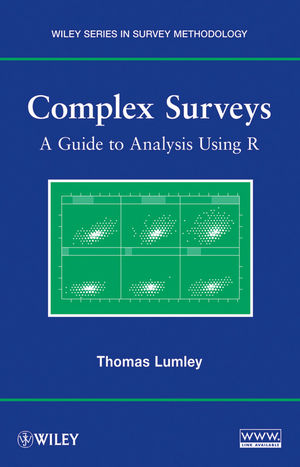Complex Surveys: A Guide to Analysis Using RISBN: 978-0-470-28430-8
Paperback
296 pages
March 2010
 This is a Print-on-Demand title. It will be printed specifically to fill your order. Please allow an additional 10-15 days delivery time. The book is not returnable.
|
||||||
Preface.
Acronyms.
1 Basic Tools.
1.1 Goals of Inference.
1.1.1 Population or Process?
1.1.2 Probability Samples.
1.1.3 Sampling Weights.
1.1.4 Design Effects.
1.2 An Introduction to the Data.
1.2.1 Real Surveys.
1.2.2 Populations.
1.3 Obtaining the Software.
1.3.1 Obtaining R.
1.3.2 Obtaining the Survey Package.
1.4 Using R.
1.4.1 Reading Plain Text Data.
1.4.2 Reading Data from Other Packages.
1.4.3 Simple Computation.
Exercises.
2 Simple and Stratified Sampling.
2.1 Analyzing Simple Random Samples.
2.1.1 Confidence Intervals.
2.1.2 Describing the Sample to R.
2.2 Stratified Sampling.
2.3 Replicate Weights.
2.3.1 Specifying Replicate Weights to R.
2.3.2 Creating Replicate Weights in R.
2.4 Other Population Summaries.
2.4.1 Quantiles.
2.4.2 Contingency Tables.
2.5 Estimates in Subpopulations.
2.6 Design of Stratified Samples.
Exercises.
3 Cluster Sampling.
3.1 Introduction.
3.1.1 Why Clusters: The NHANES II Design.
3.1.2 Single-Stage and Multistage Designs.
3.2 Describing Multistage Designs to R.
3.2.1 Strata with Only One PSU.
3.2.2 How Good is the Single-State Approximation?
3.2.3 Replicate Weights for Multistage Samples.
3.3 Sampling by Size.
3.3.1 Loss of Information from Sampling Clusters.
3.4 Repeated Measurements.
Exercises.
4 Graphics.
4.1 Why is Survey Data Different?
4.2 Plotting a Table.
4.3 One Continuous Variable.
4.3.1 Graphs Based on the Distribution Function.
4.3.2 Graphs Based on the Density.
4.4 Two Continuous Variables.
4.4.1 Scatterplots.
4.4.2 Aggregation and Smoothing.
4.4.3 Scatterplot Smoothers.
4.5 Conditioning Plots.
4.6 Maps.
4.6.1 Design and Estimation Issues.
4.6.2 Drawing Maps in R.
Exercises.
5 Ratios and Linear Regression.
5.1 Ratio Estimation.
5.1.1 Estimating Ratios.
5.1.2 Ratios for Subpopulation Estimates.
5.1.3 Ratio Estimators of Totals.
5.2 Linear Regression.
5.2.1 The Least-Squares Slope as an Estimated Population.
5.2.2 Regression Estimation of Population Totals.
5.2.3 Confounding and Other Criteria for Model Choice.
5.2.4 Linear Models in the Survey Package.
5.3 Is Weighting Needed in Regression Models?
Exercises.
6 Categorical Data Regression.
6.1 Logistic Regression.
6.1.1 Relative Risk Regression.
6.2 Ordinal Regression.
6.2.1 Other Cumulative Link Models.
6.3 Loglinear Models.
6.3.1 Choosing Models.
6.3.2 Linear Association Models.
Exercises.
7 Post-Stratification, Raking and Calibration.
7.1 Introduction.
7.2 Post-Stratification.
7.3 Raking.
7.4 Generalized Raking, GREG Estimation, and Calibration.
7.4.1 Calibration in R.
7.5 Basu’s Elephants.
7.6 Selecting Auxiliary Variables for Non-Response.
7.6.1 Direct Standardization.
7.6.2 Standard Error Estimation.
Exercises.
8 Two-Phase Sampling.
8.1 Multistage and Multiphase Sampling.
8.2 Sampling for Stratification.
8.3 The Case-Control Design.
8.3.1 Simulations: Efficiency of the Design-Based Estimator.
8.3.2 Frequency Matching.
8.4 Sampling from Existing Cohorts.
8.4.1 Logistic Regression.
8.4.2 Two-Phase Case-Control Designs in R.
8.4.3 Survival Analysis.
8.4.4 Case-Cohort Designs in R.
8.5 Using Auxiliary Information from Phase One.
8.5.1 Population Calibration for Regression Models.
8.5.2 Two-Phase Designs.
8.5.3 Some History of the Two-Phase Calibration Estimator.
Exercises.
9 Missing Data.
9.1 Item Non-Response.
9.2 Two-Phase Estimation for Missing Data.
9.2.1 Calibration for Item Non-Response.
9.2.2 Models for Response Probability.
9.2.3 Effect on Precision.
9.2.4 Doubly-Robust Estimators.
9.3 Imputation of Missing Data.
9.3.1 Describing Multiple Imputations to R.
9.3.2 Example: NHANES III Imputations.
Exercises.
10 Causal Inference.
10.1 IPTW Estimators.
10.1.1 Randomized Trials and Calibration.
10.1.2 Estimated Weights for IPTW.
10.1.3 Double Robustness.
10.2 Marginal Structural Models.
Appendix A: Analytic Details.
A.1 Asymptotics.
A.1.1 Embedding in an Infinite Sequence.
A.1.2 Asymptotic Unbiasedness.
A.1.3 Asymptotic Normality and Consistency.
A.2 Variances by Linearization.
A.2.1 Subpopulation Inference.
A.3 Tests in Contingency Tables.
A.4 Multiple Imputation.
A.5 Calibration and Influence Functions.
A.6 Calibration in Randomized Trials and ANCOVA.
Appendix B: Basic R.
B.1 Reading Data.
B.1.1 Plain Text Data.
B.2 Data Manipulation.
B.2.1 Merging.
B.2.2 Factors.
B.3 Randomness.
B.4 Methods and Objects.
B.5 Writing Functions.
B.5.1 Repetition.
B.5.2 Strings.
Appendix C: Computational Details.
C.1 Linearization.
C.1.1 Generalized Linear Models and Expected Information.
C.2 Replicate Weights.
C.2.1 Choice of Estimators.
C.2.2 Hadamard Matrices.
C.3 Scatterplot Smoothers.
C.4 Quantiles.
C.5 Bug Reports and Feature Requests.
Appendix D: Database-Backed Design Objects.
D.1 Large Data.
D.2 Setting Up Database Interfaces.
D.2.1 ODBC.
D.2.2 DBI.
Appendix E: Extending the Survey Package.
E.1 A Case Study: Negative Binomial Regression.
E.2 Using a Poisson Model.
E.3 Replicate Weights.
E.4 Linearization.
References.
Author Index.
Topic Index.



